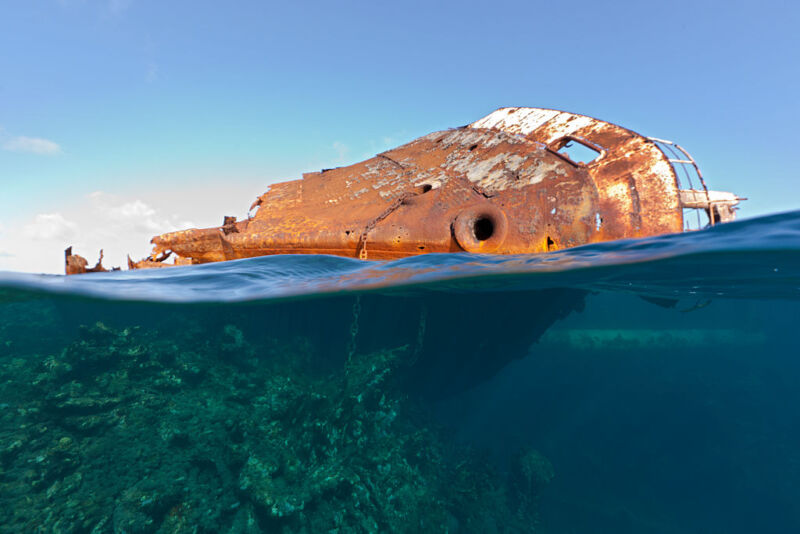The V-1302 John Mahn has sat at the bottom of the North Sea off Belgium for decades. The ship began its life in Germany as a 48-meter-long fishing vessel. However, during the Second World War, the Nazi Kriegsmarine requisitioned it for use as a patrol boat. On February 12, 1942, a squadron of six British Royal Air Force planes struck it with two bombs. It sank.
It wasn’t just the boat that sank, however. Along with it went its stores of coal and its remaining ammunition, among other chemicals. While the boat’s no longer a Nazi threat, new research suggests that it has been leaking pollution—including various heavy metals—into the North Sea ever since. This, in turn, has changed the surrounding environment at a microbial level. The research is part of the North Sea Wrecks project, an effort to aid in the identification and mitigation of wrecks and their environmental impacts in the region.
“We wanted to see if old shipwrecks in our part of the sea … were still shaping the local microbial communities and if they were still affecting the surrounding sediment. This microbial analysis is unique within the project,” Josefien Van Landuyt, a Ph.D. candidate at Ghent University and one of the paper’s authors, said in a press release.
Heavy metal
Ships (not just warships) carry and are made of myriad chemicals and materials that can impact marine ecosystems. These can include ghost nets, paints, propane, batteries, engine oil, cleaning products, and even sewage. To gauge how the former Nazi ship was impacting the surrounding environment, the team went to the site and took samples from its steel hull and from sediment at varying distances around it—from 0 meters to 80 meters, in 20-meter increments.
In the samples, they found several heavy metals like nickel and copper, along with chemicals called polycyclic aromatic hydrocarbons (PAHs), which are found in various compounds like explosives. There was also arsenic, coal, and gasoline. Perhaps not surprisingly, the researchers saw that the heavy metals and the PAHs appeared in higher concentrations closer to the wreck itself.
The presence of the wreck also impacted microbial life nearby. Microbes like Rhodobacteraceae and Chromatiaceae—which are known to degrade PAHs—appeared in higher numbers in samples with higher levels of the pollutant. Meanwhile, samples from the ship also showed various species of bacteria that the team speculates are working to corrode the steel of the hull.
How many?
How these microbial and environmental changes are impacting the surrounding environment is unclear at this point. However, high concentrations of copper can be toxic to marine life. Further, heavy metals in the sea can enter the marine food chain, getting to organisms like fish that are then eaten in large numbers by other marine life—bigger fish—which are, in turn, consumed in large numbers by humans. Through this process, called bioaccumulation, the heavy metals stick around and increase at each trophic level. Also, wrecks can crush life beneath them as they sink to the seafloor (though in the case of the V-1302 John Mahn, that ship has already sailed, so to speak).
Currently, there are around 50,000 wrecked ships in the North Sea. The V-1302 John Mahn is just one of them. According to Van Landuyt, to get a better sense of how these thousands of wrecks are affecting the sea, more sites need to be sampled.
“Although we don’t see these old shipwrecks, and many of us don’t know where they are, they can still be polluting our marine ecosystem,” she said in the press release. “In fact, their advancing age might increase the environmental risk due to corrosion, which is opening up previously enclosed spaces. As such, their environmental impact is still evolving.”
Frontiers, 2022. DOI: 10.3389/fmars.2022.1017136 (About DOIs)



3175x175(CURRENT).thumb.jpg.b05acc060982b36f5891ba728e6d953c.jpg)

Recommended Comments
There are no comments to display.
Join the conversation
You can post now and register later. If you have an account, sign in now to post with your account.
Note: Your post will require moderator approval before it will be visible.